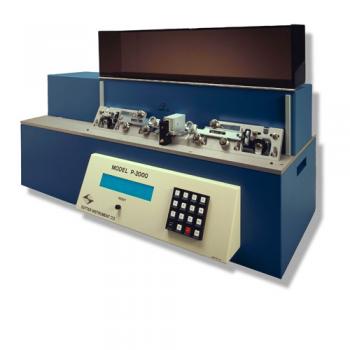Laser-Based Micropipette Puller Sutter P-2000
Horizontal pooler for quartz micropipettes with glass heating based on carbon dioxide laser. It works with quartz, borosilicate and aluminosilicate glass.
- Overview
- Specifications
- References
- Links
The P-2000 micropipette puller offers a substantial advancement in micropipette, optical fiber probe, and nanospray tip production technologies. The technology from significant experience with traditional pullers is combined with a CO2 laser-based heat source in the P-2000. Other pullers can't compare to the capabilities of this technology.
The P-2000 can work with most types of conventional glassware, but its main benefit is that it can function with quartz glass (fused silica). For many scientific applications, quartz offers outstanding material qualities. Quartz is more durable than other glassware and makes it easier to penetrate tissues that would ordinarily break regular pipettes. Users will discover that quartz is the lowest noise glass available for applications that call for a low noise glass. None of the metals used in normal glasses are present in quartz. When lit, quartz almost has no optical fluorescence.
For the P-2000, a CO2 laser was chosen as the heat source for a number of reasons, including: 1) the laser's nominal emission wavelength is close to the resonant frequency of the SiO2 lattice in glass. Thus, with the right amount of laser power, quartz and other common glasses can melt; 2) laser heat is clean and doesn't leave a metal residue on the pipette like traditional heating filaments; 3) laser heat can be turned off instantly, leaving no leftover filament heat; 4) the user can program the quantity and distribution of energy provided to the glass; and 5) laser source of heat means there are no filaments to burn out or replace.
Up to 100 distinct programs, each with up to 8 command lines, can be stored on the P-2000. Laser power intensity, scan width, trip velocity, delay/laser on time, and hard pull strength are among the programmable settings.
The diameter of the glass being utilized is a crucial factor in the P-2000's utilization. The P-2000/G is made to generate even heating on glass with an outer diameter of up to 1.2 mm. Glass with a diameter of 1.5 mm for quartz and 1.8 mm for regular glass can be used with the P-2000/G, however glass with a diameter of 1.2 mm or less performs best.
The P-2000/F performs well with small diameter fused silica capillary, which is frequently used in the production of nanospray tips, as well as small diameter glass such as optical fibers. Special puller bars and an optical alignment tailored for smaller diameter glass (with an outer diameter between 0.125 mm and 0.6 mm) are needed.
With the P-2000/F with small diameter glass, a variety of tip diameters and taper geometries may be created, just like with larger diameter glass. We have created optical fiber tips with sizes ranging from 10 nm to 5 µm.
COMMON APPLICATIONS of P-2000:
P-2000/G
- Patch clamp - single isolated
- and whole cell
- Intracellular recording
- Microinjection
- Nano probe research
- SECM
P-2000/F
- Nanospray mass spectrometry
- NSOM
- Tapering optical fibers
FEATURES
- Pulls quartz, borosilicate, and aluminosilicate glass.
- Completely programmable, including settings for the heating filament.
- The laser cannot be burned out since it does not have a maximum melting point like traditional metal filaments.P
- Pulls electrodes with tips less than 0.03 µm in diameter.
- Circuit for monitoring velocity that has been optimized for maximum sensitivity and repeatability.
- The CO2 laser is predicted to have an operating life of more than ten years under regular operation, after which the Sutter Instrument Company will refurbish the laser for a small fee.
- Programs can be individually write-protected to safeguard them from unintentional changes.
- For better program creation and troubleshooting, the total duration the heat is on throughout the pull is indicated.
- To show when a program was last modified, a date and time stamp is displayed.
- The P-2000/F is perfect for uses like nanospray and NSOM.
- Sample programs that are already preprogrammed for patch and intracellular pipettes. Additionally, the P-2000/F includes an NSOM tip program.
See also the sources, which provide helpful details relevant to the P-2000 and describe the Flaming/Brown pullers.
The instrument was used in these investigations:
- Quartz micropipettes for intracellular voltage micro- electrodes and ion selective microelectrodes.
Munoz, J.L. and Coles, J.
Journal of Neuroscience Methods: 22:57-64, 1987. - A method for exceptionally low noise single channel recordings.
Rae, J.L. and Levis, R. A.
European Journal of Physiology - Pfl??gers Archiv: 420:618-620, 1992. - Patch-clamp recording of ion channels: Interfering effects of patch pipette glass.
Zuazaga, C. and Steinacker, A.
News in Physiological Science: 5:155-159, 1990. - The use of quartz patch pipettes for low noise single channel recording.
Levis, R.A. and Rae, J. L.
Biophysical Journal: 65:1666-1677, 1993.
You can also visit site of the manufacturer.




